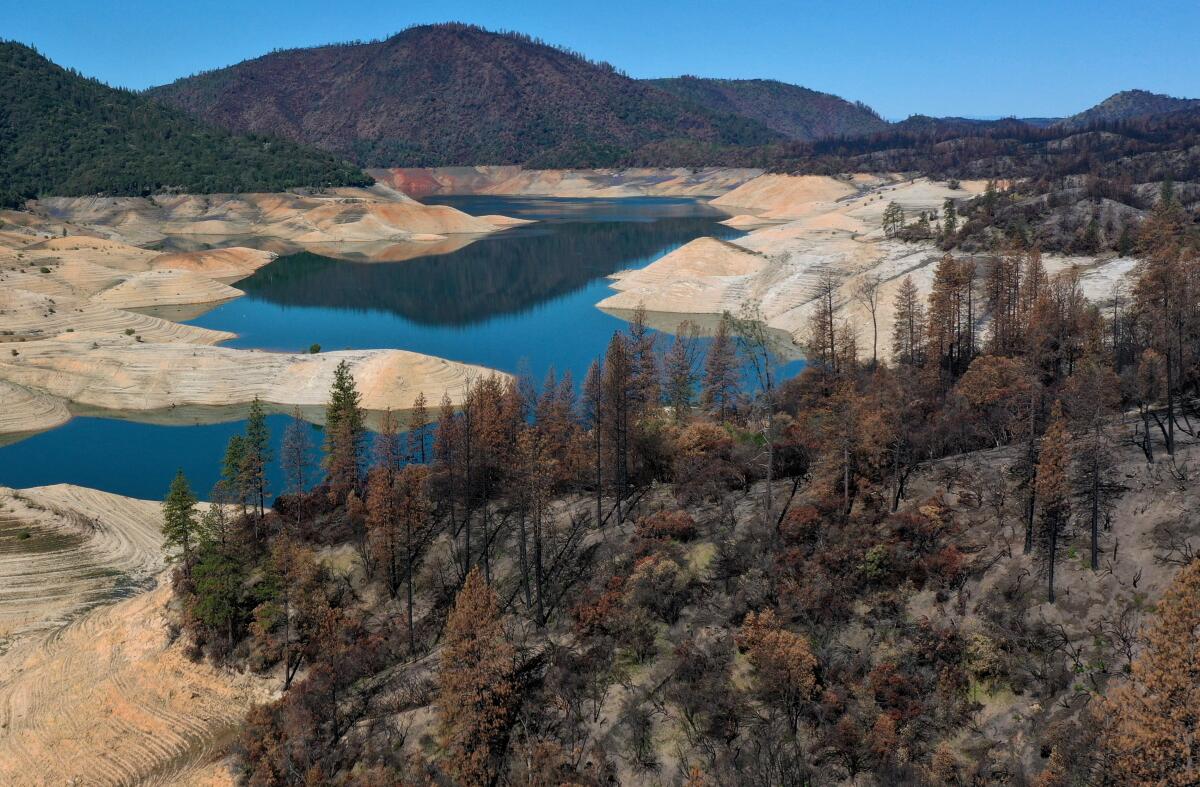Opinion: Massive water pipelines, veganism and other reader ideas for fighting the drought

Stop eating meat. Build interstate pipelines. Turn sea water into drinking water. When our letter writers start making these suggestions in earnest, that’s how I know we’re beginning to feel the effects of another drought in California.
I’ve written about our readers’ ambitious ideas to combat drought and wildfires before, and how they betray an abiding optimism in California’s ability to engineer our way out of discomfort. And we have tried: Over the last century, watersheds and mountains in Northern California and the Sierra Nevada have been extensively engineered to prevent as much water as possible from escaping to the ocean; those in Southern California have been altered to do mostly the opposite and flush water into the sea. Aqueducts bring Los Angeles potable water from the Colorado River, the Sacramento-San Joaquin River Delta and, most notoriously, the eastern Sierra.
But here we are, in a drought so soon after the previous one, with an attendant catastrophic wildfire season looming just after the last one finished setting records. Cycles of drought and deluge have always tested the limits of our water infrastructure’s ability to keep agricultural and metropolitan areas habitable and productive (even as the sources of that water face ecological devastation), but climate change threatens more fires, more dry spells and higher temperatures. California was built for a lot, but not this.
So, many of our readers are suggesting that we build in ways we haven’t before, and others say it’s time to scale back California’s growth and, yes, our meat-eating.
—————————————————
To the editor: This year’s drought demonstrates how vulnerable we are to climate change. Without mountain snow packs slowly melting through spring and summer, our farms and ranches will become parched.
We forget that California produces one-third of the vegetables in the U.S., two-thirds of the fruit and nuts. California is also the nation’s leading dairy producer.
Not only is California in a water crisis, but so is much of the southwestern United States. Lake Mead is at less than half of its capacity.
The Great Lakes hold 21% of the planet’s surface fresh water. President Biden’s priority for infrastructure must include water pipelines from the Great Lakes to the southwest and California. We cannot depend on the good fortune of nature.
Paul Milberg, Woodland Hills
..
To the editor: California’s drought cannot mainly be left to citizens to mitigate. Brown lawns and shorter showers won’t be the answer as the Colorado River dries up.
California’s fragile ecosystem cannot sustain a population of nearly 40 million people, which is larger than the entire population of Canada.
Unless politicians and city planners at every level halt endless development and their relentless pursuit of growth, it’s going to be a rough ride.
Mary Kay Gordon, Santa Monica
..
To the editor: Rarely in our discussions of drought is there acknowledgement of California’s largest water consumer — animal agriculture.
Cows, whether for their milk or their meat, require much more water and land than almonds, which are often unfairly called out. Nearly 80% of water is used by the agricultural industry, and more than half of that goes to cows, chickens, pigs and the land to raise and feed them.
Want to reduce water consumption? Adopt a more plant-based diet.
Ken Morris, Los Angeles
..
To the editor: Once again, our leaders are taking a short-sighted approach to the drought conditions in our state. They are planning on spending $3.4 billion on anything but the building of more reservoirs to collect rain water and snow melt that finds its way into the ocean.
This continued lack of long-range solutions will cause this state always to have water issues.
Joe Oviatt, San Marcos
..
To the editor: Seawater is an unlimited resource. Construction of two solar powered seawater desalination plants in California could provide treated water to both the San Joaquin and Imperial valleys with crop irrigation and drinking water for consumption by humans and animals.
One desalination plant in the Salton Sea fed by a pumping station on the Gulf of California could both revitalize the Salton Sea and provide Imperial Valley farmers with crop water.
Another solar-powered desalination plant built near the Sacramento-San Joaquin River Delta could provide San Joaquin Valley farmers and consumers with treated water fed into the California Aqueduct. Farmers could tap into the aqueduct for crop irrigation.
With climate change already having depleted groundwater wells, the use of desalinated seawater would provide for groundwater replenishment, assuming the Sierra snowpack resumes to normal levels.
Craig Simmons, Northridge
..
To the editor: Per the United States Geological Survey, 123 million gallons of fresh water flow out of the Columbia River between Oregon and Washington state into the Pacific Ocean every minute. Let’s build a pipeline that connects that water to the California Aqueduct.
James Holder, Long Beach
More to Read
A cure for the common opinion
Get thought-provoking perspectives with our weekly newsletter.
You may occasionally receive promotional content from the Los Angeles Times.







